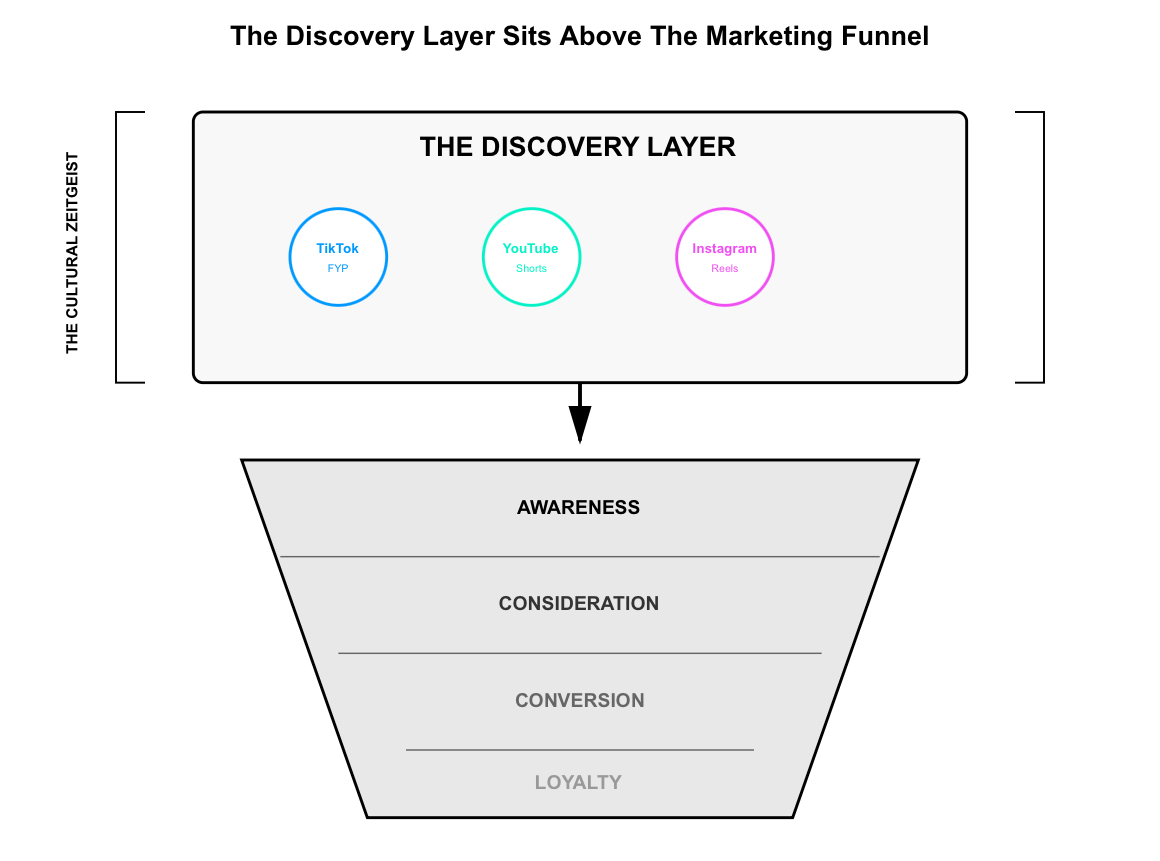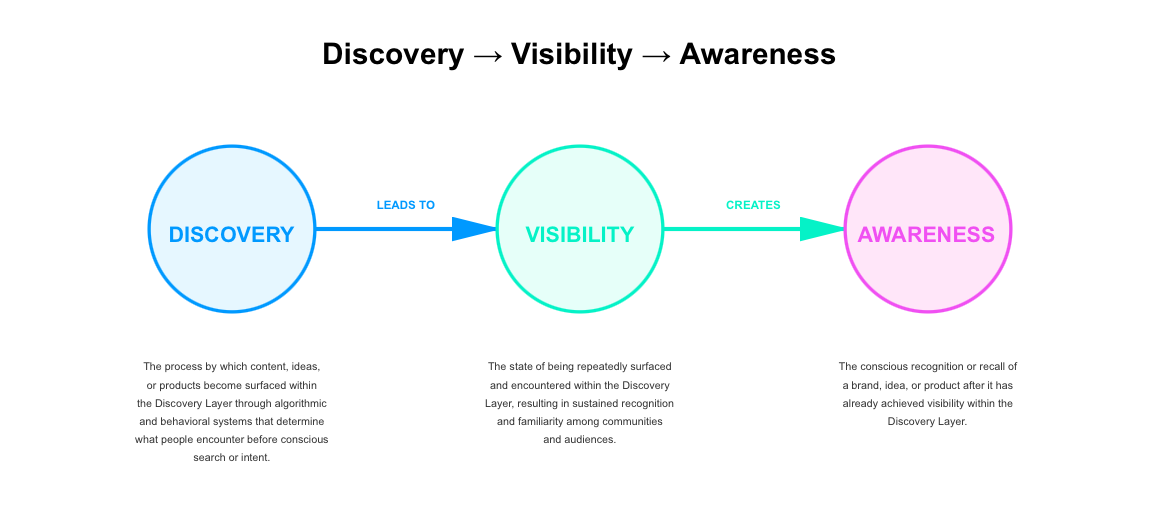The Social-First Theory Whitepaper
Context
For most of the twentieth century, marketing, communications, and brand strategy operated on a linear model of persuasion. Reach could be purchased through mass media, and consistent exposure was the primary mechanism by which products built awareness and demand. The assumption was simple: control distribution and you control attention.
That assumption no longer holds. The rise of interest-graph platforms like TikTok has fragmented attention into dynamic, self-organizing ecosystems where visibility is earned algorithmically rather than bought. Information now moves through behavioral patterns, not demographic targeting. Culture, which was once mediated by publishers and broadcasters, forms directly within digital networks that determine what people see, believe, and buy in real time.
This shift has left many organizations structurally misaligned with how markets now operate. Budgets, teams, and metrics remain optimized for paid awareness, even as discoverability, driven by participation inside the Discovery Layer, has become the true determinant of growth.
The Social-First Theory provides a framework for understanding this new environment and for redefining marketing as a function of visibility creation rather than messaging.
The Structural Shift
The biggest change in the modern marketplace is that discovery—the way people find and engage with ideas, products, and culture—has replaced distribution as the driver of growth.
In the past, visibility followed investment: companies bought attention through media spend and controlled how customers moved from awareness to purchase. That system depended on predictable distribution.
Today, visibility follows participation. People discover brands through the behaviors and conversations happening inside digital networks, not through planned campaigns. Interest-graph platforms like TikTok and Instagram Reels organize audiences by shared actions rather than demographics, determining what surfaces in culture and what disappears.
This shift matters because it changes how growth begins. Demand now starts where discovery happens. If a brand is absent from these discovery systems, it is invisible to the markets forming within them.
For leaders, the structural takeaway is that growth is now a function of being discoverable where culture is created.
The Social-First Theory
The Social-First Theory holds that visibility—and therefore growth—is now governed by a Discovery Layer shaped by the algorithms and behaviors of interest-graph platforms.
Discovery Layer: A new structural tier that sits above awareness, consideration, and conversion. It represents the algorithms, recommendation systems, and community dynamics that determine what becomes visible online.
At its core, the theory redefines how markets form. In traditional models, brands generated awareness through distribution and converted that awareness into demand through advertising and product availability. In the Social-First model, discovery precedes both. Visibility is no longer an outcome of marketing; it is the condition that enables marketing to work.
The Discovery Layer is the environment that determines what becomes visible in culture.
It is not a single platform or channel but the collective system of interest graph platforms (e.g., TikTok, Instagram Reels) where algorithms surface content based on behavioral signals rather than demographics or media spend.
Interest Graph Platforms: The algorithmic networks—such as TikTok, YouTube Shorts, and Instagram Reels—that drive what content circulates and to whom. These platforms are optimized for discovery, not distribution. They reward repeatable behaviors, prioritize content structure over creator identity, and are where most culture-led product discovery now occurs.
Every brand, creator, and idea competes inside this same system, where visibility is earned through resonance and replication instead of controlled distribution.
This layer operates through interest-graph-driven communities—networks of people clustered by shared behaviors, values, and curiosities. Within these clusters, cultural participation takes shape through recognizable units of behavior: formats, rituals, memes, and trends. These recurring patterns form the grammar of discovery, defining how content circulates, how attention compounds, and which ideas are elevated across platforms.
Interest Graph-Driven Communities: The emergent behavioral groups formed by algorithmic clustering. These communities form based on shared interests rather than social relationships, and they operate around repeated structures such as formats, rituals, trends, and memes. IGDCs are central to how discovery and cultural organization now occur on platforms like TikTok, Instagram Reels, and YouTube Shorts.
Because the Discovery Layer governs what people see, it now functions as the control system for demand formation. Culture no longer builds around media exposure; it builds around participation inside these networked environments.
For brands, this means visibility cannot be bought through awareness. The Social-First Theory holds that organizations grow when they align their marketing, product, and communication systems with the dynamics of this Discovery Layer. By participating where visibility originates, brands can convert cultural relevance into commercial advantage, turning discovery itself into a repeatable source of market growth.
Operating Social-First is therefore not a marketing choice but a necessity for remaining discoverable in the systems that now define culture and commerce.
Core Mechanics
The Discovery Layer operates through a network of interdependent forces—interest-graph algorithms, behavioral clustering, and cultural replication—that collectively determine what becomes visible, validated, and valuable in the modern marketplace.
At the foundation of this system are interest graphs, which organize people by shared behaviors instead of static attributes. Every search, swipe, and save contributes to these behavioral maps, allowing platforms to group users based on patterns of engagement. This clustering forms interest-graph-driven communities, which are organic ecosystems where cultural activity, conversation, and adoption emerge simultaneously.
Within these communities, visibility is produced through the repetition of familiar formats, rituals, memes, and trends. Formats provide the structure for participation (“before and after,” “storytime,” “get ready with me”), while rituals create recurring points of engagement (weekly resets, product routines, challenge participation). Memes and trends accelerate replication by codifying cultural shorthand that signals belonging and spreads rapidly across adjacent communities.
The algorithms governing the Discovery Layer reinforce these behaviors, rewarding replication, interaction, and consistency. Visibility compounds as behaviors repeat, and ideas validated by one community often cascade into others.
In this feedback loop, discovery is both the input and the outcome: participation fuels visibility → visibility drives adoption → adoption generates new behaviors that re-enter the system. This cyclical mechanism is what allows the Discovery Layer to continuously produce culture and, by extension, determine the pace and direction of market growth.
Foundational Assumptions
The Social-First Theory rests on a set of structural assumptions about how visibility, culture, and demand now interact within digital ecosystems.
Assumption 1: Discovery governs demand.
Demand no longer originates from planned marketing activity but from visibility achieved inside the Discovery Layer. If something is not surfaced algorithmically or circulated behaviorally, it effectively does not exist in the market consciousness.
Assumption 2: Culture functions as market infrastructure.
Culture is not a byproduct of marketing; it is the environment that determines what people pay attention to, trust, and adopt. Participation within cultural systems is now a precondition for commercial relevance.
Assumption 3: Visibility is earned through participation, not spend.
In a social-first economy, paid distribution can amplify but cannot originate visibility. Algorithmic systems reward behavioral alignment, not budget size, making credibility and community validation critical to scale.
Assumption 4: Interest-graph platforms are the dominant mediators of visibility.
These platforms, not traditional media, determine the logic of discovery by clustering users according to behavior and optimizing for engagement. They are now the infrastructure through which both culture and commerce flow.
Collectively, these assumptions define a new market reality: growth follows discoverability. Organizations that fail to adapt disappear algorithmically.
Key Implications
The Social-First Theory redefines competitive advantage. Organizations that align with the mechanics of discovery will experience sustained visibility and organic demand formation, while those that do not will lose market presence regardless of spend or legacy equity.
The first implication is strategic. Marketing, once a function of communication, now operates as a system of visibility management. The ability to participate in the Discovery Layer—where culture determines what is surfaced—has become as critical to growth as distribution or pricing. Organizations must treat discoverability as infrastructure, not as content execution.
The second implication is operational. Functional silos that separate marketing, product, and data are incompatible with discovery-driven markets. Visibility depends on how well an organization integrates these capabilities—translating cultural insight into participation, and participation into measurable adoption.
The third implication is financial. Because visibility in the Discovery Layer compounds organically through replication and participation, brands that achieve discovery fit gain a cost advantage in acquisition, retention, and brand equity formation. Paid media can amplify but cannot substitute for this compounding visibility.
Together, these implications signal a new competitive order: the firms that master discoverability will not simply communicate more effectively—they will grow more efficiently, because visibility itself has become the most valuable form of market growth.
Evidence and Illustrative Examples
The Social-First Theory is validated by brands that have translated visibility within the Discovery Layer into commercial outcomes, i.e., using cultural participation not only to earn attention but to design, launch, and scale products aligned with existing demand.
Case 1: Red Lobster’s Seafood Boil
Red Lobster’s introduction of seafood boils demonstrates how leaning into what’s circulating in the Discovery Layer can directly shape product strategy. Before the product launch, the #SeafoodBoil and #Mukbang communities on TikTok and YouTube had already established the format of communal seafood eating as a cultural behavior with millions of recurring posts.
Rather than relying on traditional menu R&D or advertising campaigns, Red Lobster identified this behavior as validated cultural demand within the Discovery Layer. By launching its own seafood boil offering, the brand effectively brought a user-generated format into its product line.
The result was immediate visibility. Organic content showcasing Red Lobster’s seafood boils replicated across existing community tags without paid promotion, positioning the brand at the center of an already thriving discovery loop and the product category became one of the chain’s most discussed offerings in years.
Commercial Implication:
This case illustrates product growth initiated by discovery. Red Lobster did not create cultural relevance—it monetized it. The Discovery Layer served as real-time R&D, revealing demand before formal market testing.
Case 2: Sally Hansen × Jarred McCain
Sally Hansen’s collaboration with Philadelphia 76ers guard Jarred McCain exemplifies how pre-existing visibility in the Discovery Layer can be converted into both cultural validation and commercial gain. McCain’s habit of painting his nails, and the resulting commentary on TikTok, made him a recurring figure across multiple interest-graph communities—from men’s basketball to beauty.
Recognizing that visibility as a market signal, Sally Hansen entered the conversation not as a sponsor but as a validator—acknowledging McCain’s nonconformity as reflective of broader shifts in self-expression. The partnership produced a dedicated product line and campaign celebrating his individuality, transforming an existing cultural discourse into a commercial opportunity.
The collaboration yielded tangible results: it introduced the brand to new male and Gen Z segments and expanded earned media visibility across both sports and beauty ecosystems.
Commercial Implication:
This case demonstrates product and revenue growth through discovery alignment. Sally Hansen converted visibility into market share by recognizing that cultural participation—when attached to a sellable product—can generate sustained demand beyond influencer exposure.
—
Together, these cases prove that firms operating Social-First can use discovery as both an intelligence layer and a commercial engine, turning cultural participation into measurable business performance.
Limitations and Boundaries of the Social-First Theory
The Social-First Theory applies most directly in environments where algorithmic discovery meaningfully shapes visibility and, by extension, demand. Its relevance diminishes where markets remain insulated from those systems.
The theory has limited predictive power in markets governed primarily by utility, regulation, or institutional procurement. In these settings, visibility contributes to reputation but not to transactional conversion. Similarly, industries with low social participation or minimal platform presence—such as heavy manufacturing or B2B services—may not exhibit discovery-driven demand cycles.
Another boundary lies in measurement. Discovery-layer visibility is dynamic and distributed, making it difficult to capture with traditional marketing metrics. Organizations must therefore treat Social-First operations as a directional system rather than a deterministic one—strongly correlated with growth but not sufficient in isolation.
Finally, the theory presumes ongoing platform stability. Should interest-graph algorithms materially change or decentralize, the mechanics of discovery and visibility would evolve accordingly. The model remains robust as long as visibility is behaviorally allocated and culture continues to function as a precursor to demand.
Conclusion
The governing structure of modern markets has changed. Discovery now determines visibility, and visibility determines growth.
The Social-First Theory provides a clear mandate: operate where visibility originates (in the Discovery Layer). The Discovery Layer is not a marketing channel—it is the system that allocates cultural and commercial relevance. Every idea, product, and brand now competes within it, whether intentionally or not.
Ultimately, growth is no longer secured through message control or paid reach. It is earned through participation in the environments where culture, attention, and demand form simultaneously. Organizations that align with this reality will compound visibility and market share; those that do not will become invisible, regardless of spend.
The path forward is simple in principle and demanding in practice: build a company that is discoverable by design. Treat cultural intelligence as market intelligence. Make visibility a leadership priority. Because in a discovery-governed economy, being seen is not the outcome of success—it is the condition for it.




